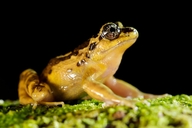|
Alsodes norae Cuevas, 2008
| family: Alsodidae genus: Alsodes |
| Species Description: Cuevas CC 2008 A new species of the genus Alsodes (Anura: Neobatrachia) from the Nothofagus forest, coastal range, southern Chile, identified by its karyotype. Zootaxa 177:43-53. | |
 © 2013 Bert Willaert (1 of 6) |
|
|
|
Description In life, Alsodes norae exhibits vivid yellow and black coloration with a slight granular appearance on the dorsal surfaces of the head, forelimbs, and hindlimbs. A yellowish triangle is present on the head, between the snout tip and the anterior border of the eyes. There is a dark bat-shaped marking with spread wings along the dorsal surface of the head down to the mid-body. Thin dark transverse bars are present on the dorsal surfaces of the hindlimbs. Ventral surfaces of thighs are yellow, and the venter is light beige with dark reticulations. The top part of the iris is golden or bronze-yellowish with black reticulations (Cuevas 2008). In preservative, the dorsal surface of head, forelimbs, hindlimbs, and body appear slightly grey. The dark bat figure is visible in preserved specimens, extending from mid eye level to the insertion of arms, and continuing to the vent in the form of many parallel lines. A light gray triangular marking is present on the head. A dark line passes over the postocular fold. The venter, throat, and ventral surfaces of arms and thighs have dark reticulations in younger animals and are whitish in older specimens (Cuevas 2008). Distribution and Habitat Country distribution from AmphibiaWeb's database: Chile
Life History, Abundance, Activity, and Special Behaviors Comments The diploid chromosome number is 30, unlike all other Alsodes from the Coastal Range: A. barrioi 2n=34; A. nodosus 2n=22; A. valdiviensis 2n=26; A. vanzolinii 2n=26. (Cuevas and Formas 2005; Cuevas 2008). In addition, A. norae has four uniarmed pairs of chromosomes, while A. barrioi has eight, A. valdiviensis has none, and A. vanzolinii has one pair of uniarmed chromosomes; A. nodosus was not reported (Cuevas 2008). A nucleolar organizing region (NOR) is present on chromosome pair 4 in Alsodes norae (Cuevas 2008).
References
Cei, J. M. (1980). ''Amphibians of Argentina.'' Monitore Zoologica Italiano, New Series Monografia, Firenze, 2, 1-609. Cuevas P., C. C. (2008). ''A new species of the genus Alsodes (Anura: Neobatrachia) from the Nothofagus forest, coastal range, southern Chile, identified by its karyotype.'' Zootaxa, 1771, 43-53. Cuevas, C. C. and Formas, J. R. (2005). ''A new frog of the genus Alsodes (Leptodactylidae) from the Tolhuaca National Park, Andes Range, southern Chile.'' Amphibia-Reptilia, 26, 39-48. Cuevas, C. C., and Formas, J.R. (2001). ''A new species of Alsodes (Amphibia, Anura, Leptodactylidae) from Central Chile.'' Amphibia-Reptilia, 22, 187-198. Formas, J. R., Cuevas, C. C., and Brieva, L. M. (2002). ''A new species of Alsodes (Anura, Leptodactylidae) from Cerro Mirador, Cordillera Pelada, southern Chile.'' Proceedings of the Biological Society of Washington, 115, 708-719. Formas, J. R., Cuevas, C. C., and Nuñez, J. (1998). ''A new species of Alsodes (Amphibia, Anura, Leptodactylidae) from Southern Chile.'' Proceedings of the Biological Society of Washington, 115, 708-719. Oberdorfer, E. (1960). ''Pflanzensoziologische Studien in Chile. Ein Vergleich mit Europa.'' Flora et Vegetatio Mundi, 2, 1-208. Veblen, T. T., Schlegel, F. M., and Oltremari, J. V. (1980). ''Temperate broad-leaved evergreen forest of South America.'' Temperate Broad-Leaved Evergreen Forests. J. D. Ovington, eds., Elsevier Science Publishers, Amsterdam. Originally submitted by: Henry Zhu (first posted 2008-10-24) Edited by: Kellie Whittaker (2009-02-05) Species Account Citation: AmphibiaWeb 2009 Alsodes norae <https://amphibiaweb.org/species/7115> University of California, Berkeley, CA, USA. Accessed Jun 14, 2025.
Feedback or comments about this page.
Citation: AmphibiaWeb. 2025. <https://amphibiaweb.org> University of California, Berkeley, CA, USA. Accessed 14 Jun 2025. AmphibiaWeb's policy on data use. |


 Map of Life
Map of Life